English Assignments
VerifiedAdded on 2023/04/19
|12
|3217
|71
AI Summary
This document provides an overview of English assignments, including a unit plan, pedagogical approaches, resources, assessment methods, and references. It discusses the learning objectives, lesson overviews, and assessment tasks for a specific English unit. The document also explores different pedagogical approaches and resources used to enhance English learning. The assessment section covers pre-assessment and formative and summative assessment methods. Overall, this document offers valuable insights into English assignments and teaching strategies.
Contribute Materials
Your contribution can guide someone’s learning journey. Share your
documents today.
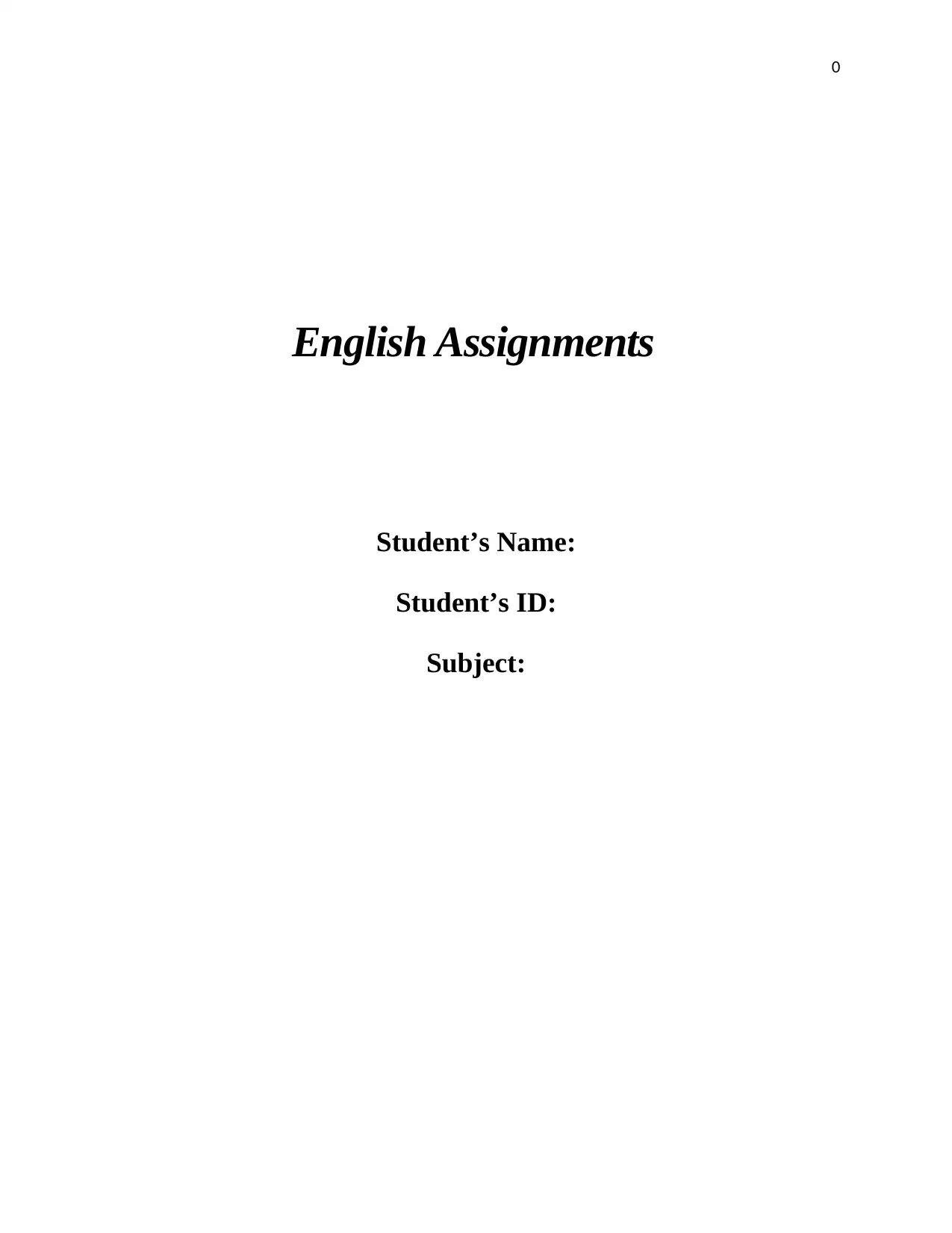
0
English Assignments
Student’s Name:
Student’s ID:
Subject:
English Assignments
Student’s Name:
Student’s ID:
Subject:
Secure Best Marks with AI Grader
Need help grading? Try our AI Grader for instant feedback on your assignments.
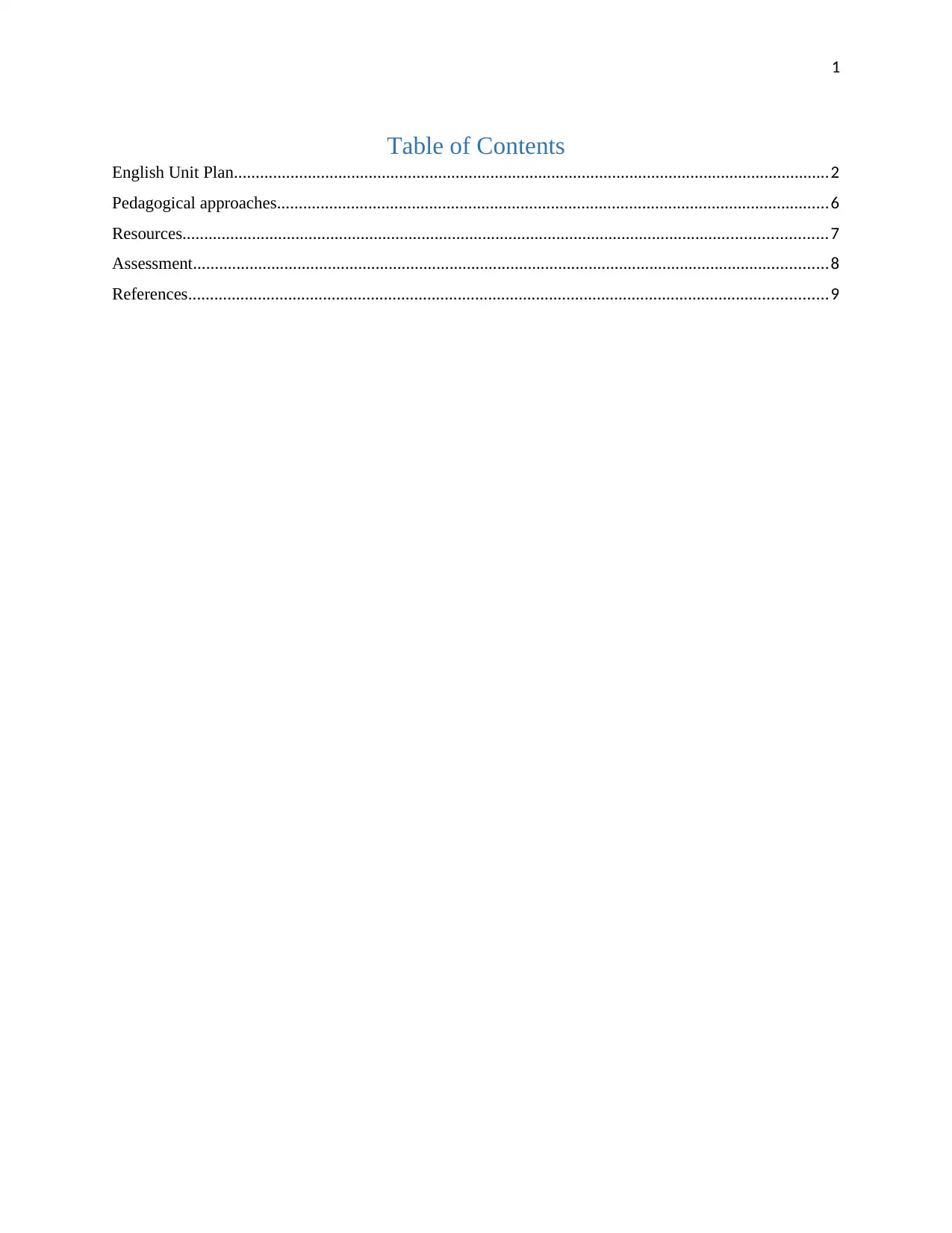
1
Table of Contents
English Unit Plan.........................................................................................................................................2
Pedagogical approaches...............................................................................................................................6
Resources....................................................................................................................................................7
Assessment..................................................................................................................................................8
References...................................................................................................................................................9
Table of Contents
English Unit Plan.........................................................................................................................................2
Pedagogical approaches...............................................................................................................................6
Resources....................................................................................................................................................7
Assessment..................................................................................................................................................8
References...................................................................................................................................................9
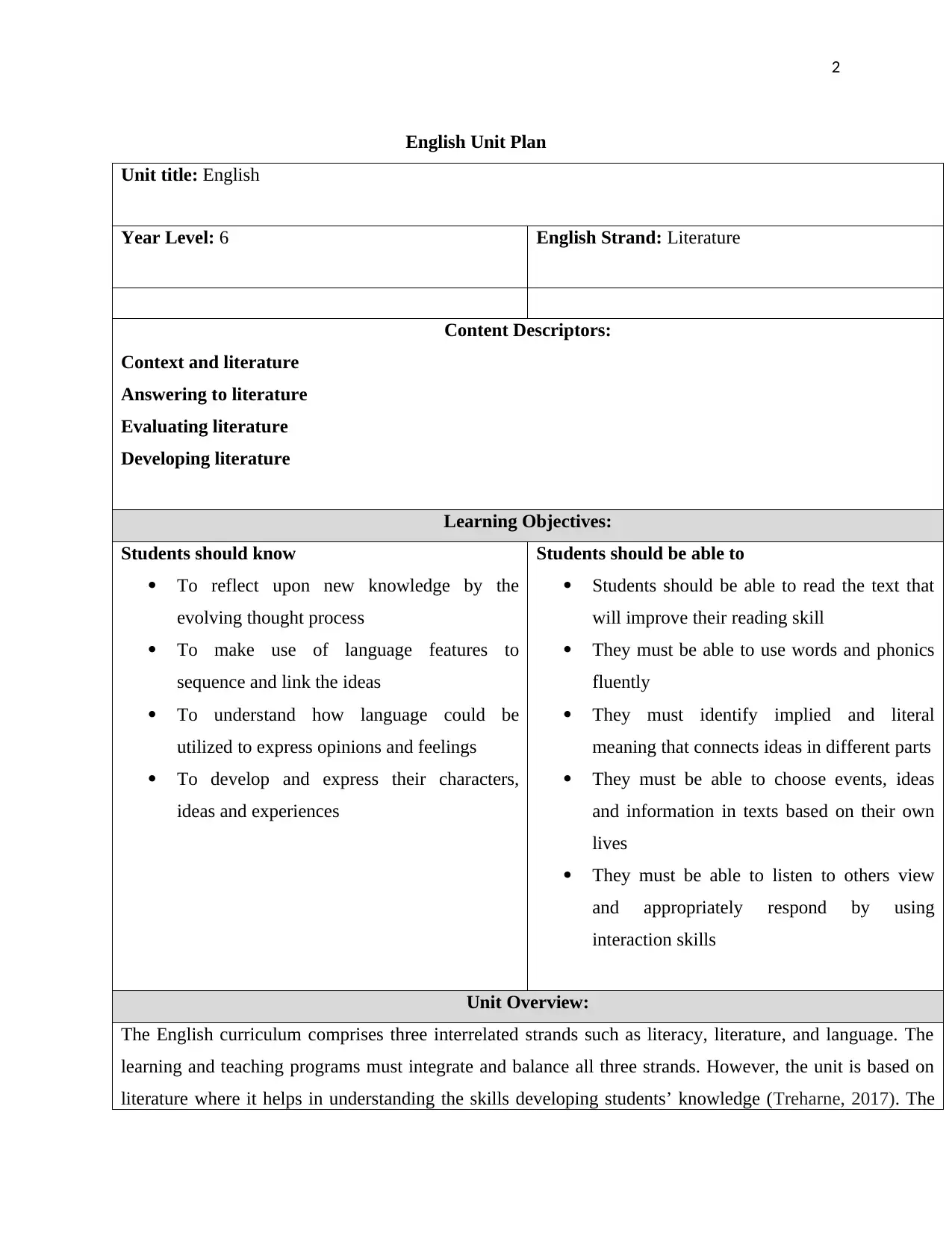
2
English Unit Plan
Unit title: English
Year Level: 6 English Strand: Literature
Content Descriptors:
Context and literature
Answering to literature
Evaluating literature
Developing literature
Learning Objectives:
Students should know
To reflect upon new knowledge by the
evolving thought process
To make use of language features to
sequence and link the ideas
To understand how language could be
utilized to express opinions and feelings
To develop and express their characters,
ideas and experiences
Students should be able to
Students should be able to read the text that
will improve their reading skill
They must be able to use words and phonics
fluently
They must identify implied and literal
meaning that connects ideas in different parts
They must be able to choose events, ideas
and information in texts based on their own
lives
They must be able to listen to others view
and appropriately respond by using
interaction skills
Unit Overview:
The English curriculum comprises three interrelated strands such as literacy, literature, and language. The
learning and teaching programs must integrate and balance all three strands. However, the unit is based on
literature where it helps in understanding the skills developing students’ knowledge (Treharne, 2017). The
English Unit Plan
Unit title: English
Year Level: 6 English Strand: Literature
Content Descriptors:
Context and literature
Answering to literature
Evaluating literature
Developing literature
Learning Objectives:
Students should know
To reflect upon new knowledge by the
evolving thought process
To make use of language features to
sequence and link the ideas
To understand how language could be
utilized to express opinions and feelings
To develop and express their characters,
ideas and experiences
Students should be able to
Students should be able to read the text that
will improve their reading skill
They must be able to use words and phonics
fluently
They must identify implied and literal
meaning that connects ideas in different parts
They must be able to choose events, ideas
and information in texts based on their own
lives
They must be able to listen to others view
and appropriately respond by using
interaction skills
Unit Overview:
The English curriculum comprises three interrelated strands such as literacy, literature, and language. The
learning and teaching programs must integrate and balance all three strands. However, the unit is based on
literature where it helps in understanding the skills developing students’ knowledge (Treharne, 2017). The
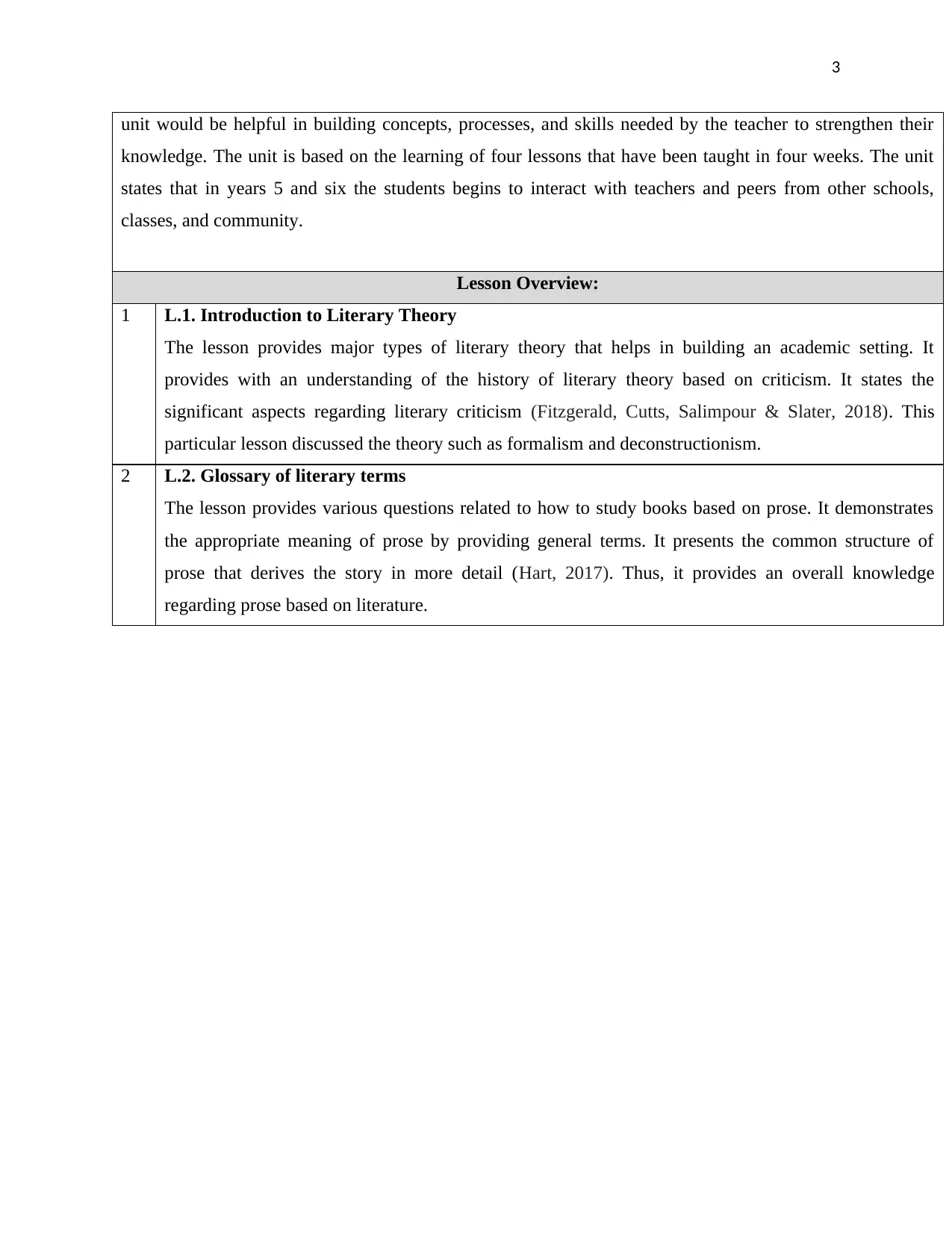
3
unit would be helpful in building concepts, processes, and skills needed by the teacher to strengthen their
knowledge. The unit is based on the learning of four lessons that have been taught in four weeks. The unit
states that in years 5 and six the students begins to interact with teachers and peers from other schools,
classes, and community.
Lesson Overview:
1 L.1. Introduction to Literary Theory
The lesson provides major types of literary theory that helps in building an academic setting. It
provides with an understanding of the history of literary theory based on criticism. It states the
significant aspects regarding literary criticism (Fitzgerald, Cutts, Salimpour & Slater, 2018). This
particular lesson discussed the theory such as formalism and deconstructionism.
2 L.2. Glossary of literary terms
The lesson provides various questions related to how to study books based on prose. It demonstrates
the appropriate meaning of prose by providing general terms. It presents the common structure of
prose that derives the story in more detail (Hart, 2017). Thus, it provides an overall knowledge
regarding prose based on literature.
unit would be helpful in building concepts, processes, and skills needed by the teacher to strengthen their
knowledge. The unit is based on the learning of four lessons that have been taught in four weeks. The unit
states that in years 5 and six the students begins to interact with teachers and peers from other schools,
classes, and community.
Lesson Overview:
1 L.1. Introduction to Literary Theory
The lesson provides major types of literary theory that helps in building an academic setting. It
provides with an understanding of the history of literary theory based on criticism. It states the
significant aspects regarding literary criticism (Fitzgerald, Cutts, Salimpour & Slater, 2018). This
particular lesson discussed the theory such as formalism and deconstructionism.
2 L.2. Glossary of literary terms
The lesson provides various questions related to how to study books based on prose. It demonstrates
the appropriate meaning of prose by providing general terms. It presents the common structure of
prose that derives the story in more detail (Hart, 2017). Thus, it provides an overall knowledge
regarding prose based on literature.
Secure Best Marks with AI Grader
Need help grading? Try our AI Grader for instant feedback on your assignments.
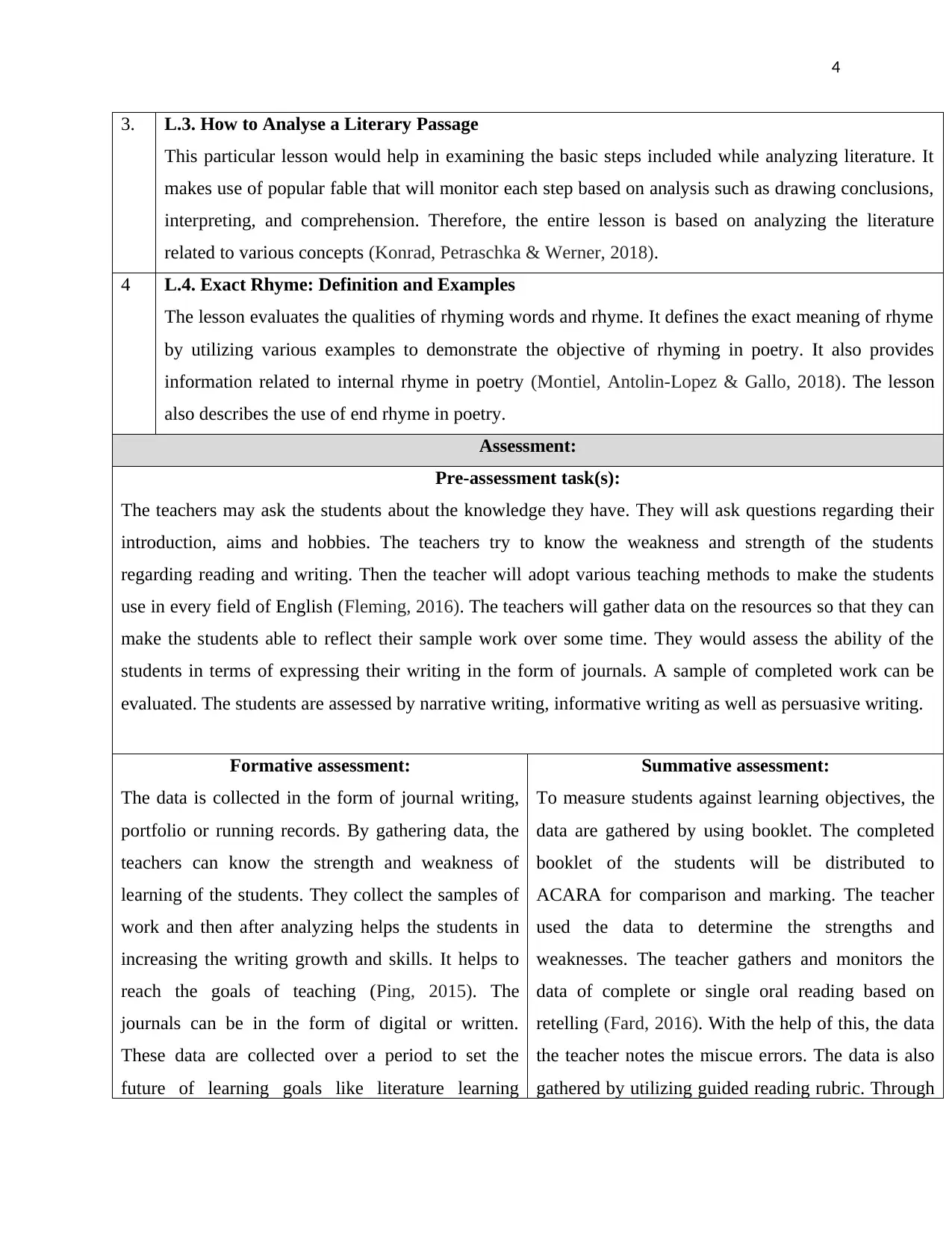
4
3. L.3. How to Analyse a Literary Passage
This particular lesson would help in examining the basic steps included while analyzing literature. It
makes use of popular fable that will monitor each step based on analysis such as drawing conclusions,
interpreting, and comprehension. Therefore, the entire lesson is based on analyzing the literature
related to various concepts (Konrad, Petraschka & Werner, 2018).
4 L.4. Exact Rhyme: Definition and Examples
The lesson evaluates the qualities of rhyming words and rhyme. It defines the exact meaning of rhyme
by utilizing various examples to demonstrate the objective of rhyming in poetry. It also provides
information related to internal rhyme in poetry (Montiel, Antolin-Lopez & Gallo, 2018). The lesson
also describes the use of end rhyme in poetry.
Assessment:
Pre-assessment task(s):
The teachers may ask the students about the knowledge they have. They will ask questions regarding their
introduction, aims and hobbies. The teachers try to know the weakness and strength of the students
regarding reading and writing. Then the teacher will adopt various teaching methods to make the students
use in every field of English (Fleming, 2016). The teachers will gather data on the resources so that they can
make the students able to reflect their sample work over some time. They would assess the ability of the
students in terms of expressing their writing in the form of journals. A sample of completed work can be
evaluated. The students are assessed by narrative writing, informative writing as well as persuasive writing.
Formative assessment:
The data is collected in the form of journal writing,
portfolio or running records. By gathering data, the
teachers can know the strength and weakness of
learning of the students. They collect the samples of
work and then after analyzing helps the students in
increasing the writing growth and skills. It helps to
reach the goals of teaching (Ping, 2015). The
journals can be in the form of digital or written.
These data are collected over a period to set the
future of learning goals like literature learning
Summative assessment:
To measure students against learning objectives, the
data are gathered by using booklet. The completed
booklet of the students will be distributed to
ACARA for comparison and marking. The teacher
used the data to determine the strengths and
weaknesses. The teacher gathers and monitors the
data of complete or single oral reading based on
retelling (Fard, 2016). With the help of this, the data
the teacher notes the miscue errors. The data is also
gathered by utilizing guided reading rubric. Through
3. L.3. How to Analyse a Literary Passage
This particular lesson would help in examining the basic steps included while analyzing literature. It
makes use of popular fable that will monitor each step based on analysis such as drawing conclusions,
interpreting, and comprehension. Therefore, the entire lesson is based on analyzing the literature
related to various concepts (Konrad, Petraschka & Werner, 2018).
4 L.4. Exact Rhyme: Definition and Examples
The lesson evaluates the qualities of rhyming words and rhyme. It defines the exact meaning of rhyme
by utilizing various examples to demonstrate the objective of rhyming in poetry. It also provides
information related to internal rhyme in poetry (Montiel, Antolin-Lopez & Gallo, 2018). The lesson
also describes the use of end rhyme in poetry.
Assessment:
Pre-assessment task(s):
The teachers may ask the students about the knowledge they have. They will ask questions regarding their
introduction, aims and hobbies. The teachers try to know the weakness and strength of the students
regarding reading and writing. Then the teacher will adopt various teaching methods to make the students
use in every field of English (Fleming, 2016). The teachers will gather data on the resources so that they can
make the students able to reflect their sample work over some time. They would assess the ability of the
students in terms of expressing their writing in the form of journals. A sample of completed work can be
evaluated. The students are assessed by narrative writing, informative writing as well as persuasive writing.
Formative assessment:
The data is collected in the form of journal writing,
portfolio or running records. By gathering data, the
teachers can know the strength and weakness of
learning of the students. They collect the samples of
work and then after analyzing helps the students in
increasing the writing growth and skills. It helps to
reach the goals of teaching (Ping, 2015). The
journals can be in the form of digital or written.
These data are collected over a period to set the
future of learning goals like literature learning
Summative assessment:
To measure students against learning objectives, the
data are gathered by using booklet. The completed
booklet of the students will be distributed to
ACARA for comparison and marking. The teacher
used the data to determine the strengths and
weaknesses. The teacher gathers and monitors the
data of complete or single oral reading based on
retelling (Fard, 2016). With the help of this, the data
the teacher notes the miscue errors. The data is also
gathered by utilizing guided reading rubric. Through
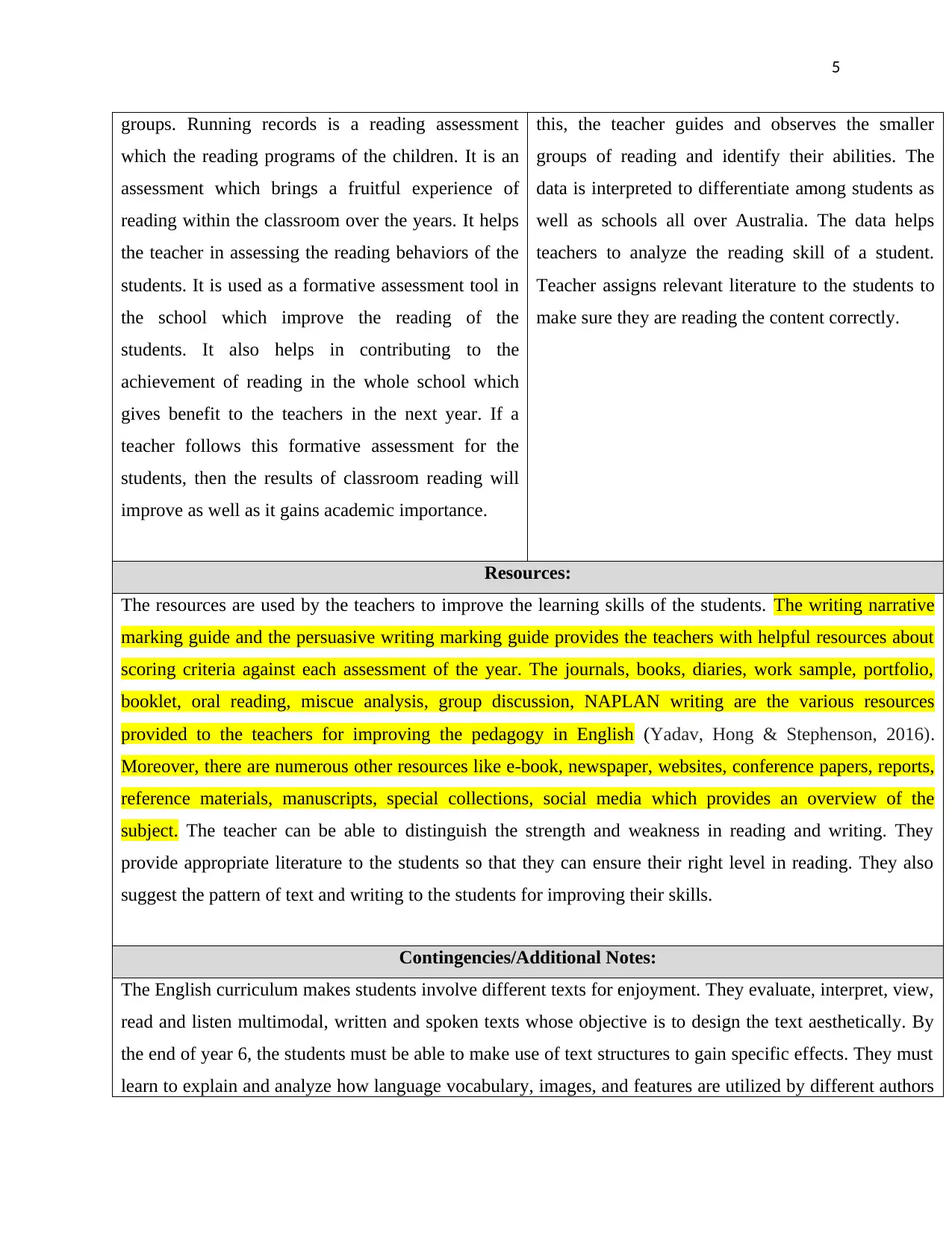
5
groups. Running records is a reading assessment
which the reading programs of the children. It is an
assessment which brings a fruitful experience of
reading within the classroom over the years. It helps
the teacher in assessing the reading behaviors of the
students. It is used as a formative assessment tool in
the school which improve the reading of the
students. It also helps in contributing to the
achievement of reading in the whole school which
gives benefit to the teachers in the next year. If a
teacher follows this formative assessment for the
students, then the results of classroom reading will
improve as well as it gains academic importance.
this, the teacher guides and observes the smaller
groups of reading and identify their abilities. The
data is interpreted to differentiate among students as
well as schools all over Australia. The data helps
teachers to analyze the reading skill of a student.
Teacher assigns relevant literature to the students to
make sure they are reading the content correctly.
Resources:
The resources are used by the teachers to improve the learning skills of the students. The writing narrative
marking guide and the persuasive writing marking guide provides the teachers with helpful resources about
scoring criteria against each assessment of the year. The journals, books, diaries, work sample, portfolio,
booklet, oral reading, miscue analysis, group discussion, NAPLAN writing are the various resources
provided to the teachers for improving the pedagogy in English (Yadav, Hong & Stephenson, 2016).
Moreover, there are numerous other resources like e-book, newspaper, websites, conference papers, reports,
reference materials, manuscripts, special collections, social media which provides an overview of the
subject. The teacher can be able to distinguish the strength and weakness in reading and writing. They
provide appropriate literature to the students so that they can ensure their right level in reading. They also
suggest the pattern of text and writing to the students for improving their skills.
Contingencies/Additional Notes:
The English curriculum makes students involve different texts for enjoyment. They evaluate, interpret, view,
read and listen multimodal, written and spoken texts whose objective is to design the text aesthetically. By
the end of year 6, the students must be able to make use of text structures to gain specific effects. They must
learn to explain and analyze how language vocabulary, images, and features are utilized by different authors
groups. Running records is a reading assessment
which the reading programs of the children. It is an
assessment which brings a fruitful experience of
reading within the classroom over the years. It helps
the teacher in assessing the reading behaviors of the
students. It is used as a formative assessment tool in
the school which improve the reading of the
students. It also helps in contributing to the
achievement of reading in the whole school which
gives benefit to the teachers in the next year. If a
teacher follows this formative assessment for the
students, then the results of classroom reading will
improve as well as it gains academic importance.
this, the teacher guides and observes the smaller
groups of reading and identify their abilities. The
data is interpreted to differentiate among students as
well as schools all over Australia. The data helps
teachers to analyze the reading skill of a student.
Teacher assigns relevant literature to the students to
make sure they are reading the content correctly.
Resources:
The resources are used by the teachers to improve the learning skills of the students. The writing narrative
marking guide and the persuasive writing marking guide provides the teachers with helpful resources about
scoring criteria against each assessment of the year. The journals, books, diaries, work sample, portfolio,
booklet, oral reading, miscue analysis, group discussion, NAPLAN writing are the various resources
provided to the teachers for improving the pedagogy in English (Yadav, Hong & Stephenson, 2016).
Moreover, there are numerous other resources like e-book, newspaper, websites, conference papers, reports,
reference materials, manuscripts, special collections, social media which provides an overview of the
subject. The teacher can be able to distinguish the strength and weakness in reading and writing. They
provide appropriate literature to the students so that they can ensure their right level in reading. They also
suggest the pattern of text and writing to the students for improving their skills.
Contingencies/Additional Notes:
The English curriculum makes students involve different texts for enjoyment. They evaluate, interpret, view,
read and listen multimodal, written and spoken texts whose objective is to design the text aesthetically. By
the end of year 6, the students must be able to make use of text structures to gain specific effects. They must
learn to explain and analyze how language vocabulary, images, and features are utilized by different authors
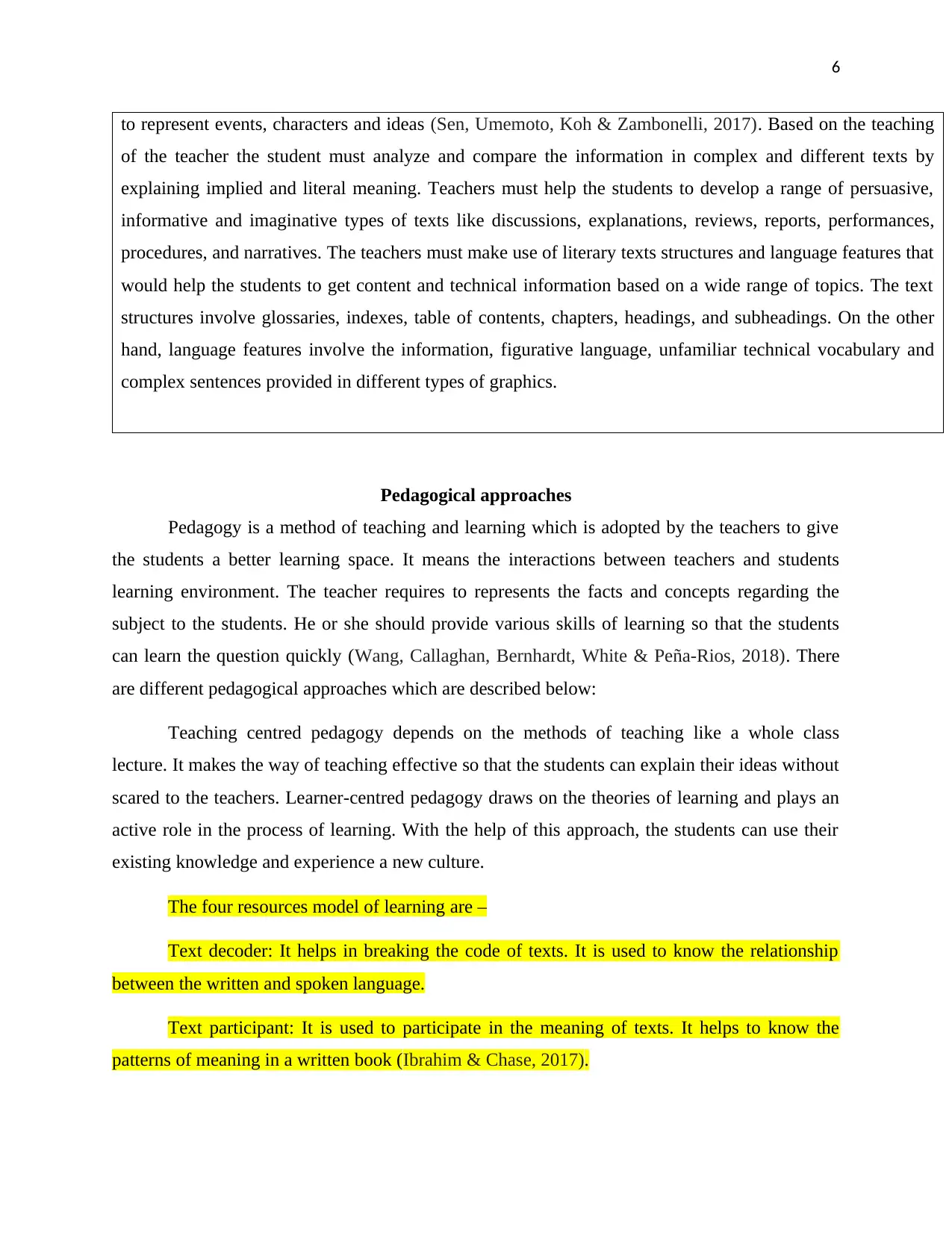
6
to represent events, characters and ideas (Sen, Umemoto, Koh & Zambonelli, 2017). Based on the teaching
of the teacher the student must analyze and compare the information in complex and different texts by
explaining implied and literal meaning. Teachers must help the students to develop a range of persuasive,
informative and imaginative types of texts like discussions, explanations, reviews, reports, performances,
procedures, and narratives. The teachers must make use of literary texts structures and language features that
would help the students to get content and technical information based on a wide range of topics. The text
structures involve glossaries, indexes, table of contents, chapters, headings, and subheadings. On the other
hand, language features involve the information, figurative language, unfamiliar technical vocabulary and
complex sentences provided in different types of graphics.
Pedagogical approaches
Pedagogy is a method of teaching and learning which is adopted by the teachers to give
the students a better learning space. It means the interactions between teachers and students
learning environment. The teacher requires to represents the facts and concepts regarding the
subject to the students. He or she should provide various skills of learning so that the students
can learn the question quickly (Wang, Callaghan, Bernhardt, White & Peña-Rios, 2018). There
are different pedagogical approaches which are described below:
Teaching centred pedagogy depends on the methods of teaching like a whole class
lecture. It makes the way of teaching effective so that the students can explain their ideas without
scared to the teachers. Learner-centred pedagogy draws on the theories of learning and plays an
active role in the process of learning. With the help of this approach, the students can use their
existing knowledge and experience a new culture.
The four resources model of learning are –
Text decoder: It helps in breaking the code of texts. It is used to know the relationship
between the written and spoken language.
Text participant: It is used to participate in the meaning of texts. It helps to know the
patterns of meaning in a written book (Ibrahim & Chase, 2017).
to represent events, characters and ideas (Sen, Umemoto, Koh & Zambonelli, 2017). Based on the teaching
of the teacher the student must analyze and compare the information in complex and different texts by
explaining implied and literal meaning. Teachers must help the students to develop a range of persuasive,
informative and imaginative types of texts like discussions, explanations, reviews, reports, performances,
procedures, and narratives. The teachers must make use of literary texts structures and language features that
would help the students to get content and technical information based on a wide range of topics. The text
structures involve glossaries, indexes, table of contents, chapters, headings, and subheadings. On the other
hand, language features involve the information, figurative language, unfamiliar technical vocabulary and
complex sentences provided in different types of graphics.
Pedagogical approaches
Pedagogy is a method of teaching and learning which is adopted by the teachers to give
the students a better learning space. It means the interactions between teachers and students
learning environment. The teacher requires to represents the facts and concepts regarding the
subject to the students. He or she should provide various skills of learning so that the students
can learn the question quickly (Wang, Callaghan, Bernhardt, White & Peña-Rios, 2018). There
are different pedagogical approaches which are described below:
Teaching centred pedagogy depends on the methods of teaching like a whole class
lecture. It makes the way of teaching effective so that the students can explain their ideas without
scared to the teachers. Learner-centred pedagogy draws on the theories of learning and plays an
active role in the process of learning. With the help of this approach, the students can use their
existing knowledge and experience a new culture.
The four resources model of learning are –
Text decoder: It helps in breaking the code of texts. It is used to know the relationship
between the written and spoken language.
Text participant: It is used to participate in the meaning of texts. It helps to know the
patterns of meaning in a written book (Ibrahim & Chase, 2017).
Paraphrase This Document
Need a fresh take? Get an instant paraphrase of this document with our AI Paraphraser
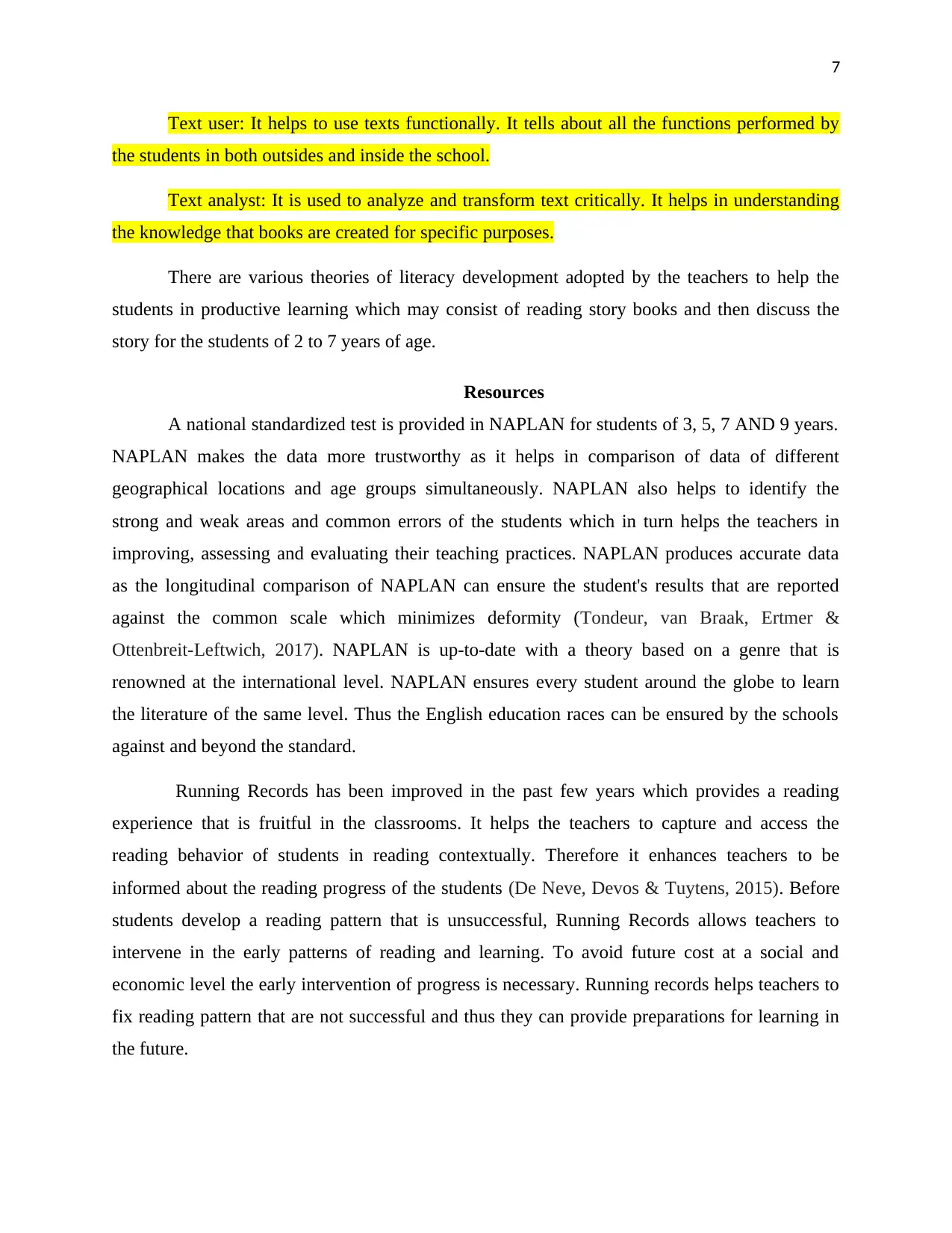
7
Text user: It helps to use texts functionally. It tells about all the functions performed by
the students in both outsides and inside the school.
Text analyst: It is used to analyze and transform text critically. It helps in understanding
the knowledge that books are created for specific purposes.
There are various theories of literacy development adopted by the teachers to help the
students in productive learning which may consist of reading story books and then discuss the
story for the students of 2 to 7 years of age.
Resources
A national standardized test is provided in NAPLAN for students of 3, 5, 7 AND 9 years.
NAPLAN makes the data more trustworthy as it helps in comparison of data of different
geographical locations and age groups simultaneously. NAPLAN also helps to identify the
strong and weak areas and common errors of the students which in turn helps the teachers in
improving, assessing and evaluating their teaching practices. NAPLAN produces accurate data
as the longitudinal comparison of NAPLAN can ensure the student's results that are reported
against the common scale which minimizes deformity (Tondeur, van Braak, Ertmer &
Ottenbreit-Leftwich, 2017). NAPLAN is up-to-date with a theory based on a genre that is
renowned at the international level. NAPLAN ensures every student around the globe to learn
the literature of the same level. Thus the English education races can be ensured by the schools
against and beyond the standard.
Running Records has been improved in the past few years which provides a reading
experience that is fruitful in the classrooms. It helps the teachers to capture and access the
reading behavior of students in reading contextually. Therefore it enhances teachers to be
informed about the reading progress of the students (De Neve, Devos & Tuytens, 2015). Before
students develop a reading pattern that is unsuccessful, Running Records allows teachers to
intervene in the early patterns of reading and learning. To avoid future cost at a social and
economic level the early intervention of progress is necessary. Running records helps teachers to
fix reading pattern that are not successful and thus they can provide preparations for learning in
the future.
Text user: It helps to use texts functionally. It tells about all the functions performed by
the students in both outsides and inside the school.
Text analyst: It is used to analyze and transform text critically. It helps in understanding
the knowledge that books are created for specific purposes.
There are various theories of literacy development adopted by the teachers to help the
students in productive learning which may consist of reading story books and then discuss the
story for the students of 2 to 7 years of age.
Resources
A national standardized test is provided in NAPLAN for students of 3, 5, 7 AND 9 years.
NAPLAN makes the data more trustworthy as it helps in comparison of data of different
geographical locations and age groups simultaneously. NAPLAN also helps to identify the
strong and weak areas and common errors of the students which in turn helps the teachers in
improving, assessing and evaluating their teaching practices. NAPLAN produces accurate data
as the longitudinal comparison of NAPLAN can ensure the student's results that are reported
against the common scale which minimizes deformity (Tondeur, van Braak, Ertmer &
Ottenbreit-Leftwich, 2017). NAPLAN is up-to-date with a theory based on a genre that is
renowned at the international level. NAPLAN ensures every student around the globe to learn
the literature of the same level. Thus the English education races can be ensured by the schools
against and beyond the standard.
Running Records has been improved in the past few years which provides a reading
experience that is fruitful in the classrooms. It helps the teachers to capture and access the
reading behavior of students in reading contextually. Therefore it enhances teachers to be
informed about the reading progress of the students (De Neve, Devos & Tuytens, 2015). Before
students develop a reading pattern that is unsuccessful, Running Records allows teachers to
intervene in the early patterns of reading and learning. To avoid future cost at a social and
economic level the early intervention of progress is necessary. Running records helps teachers to
fix reading pattern that are not successful and thus they can provide preparations for learning in
the future.
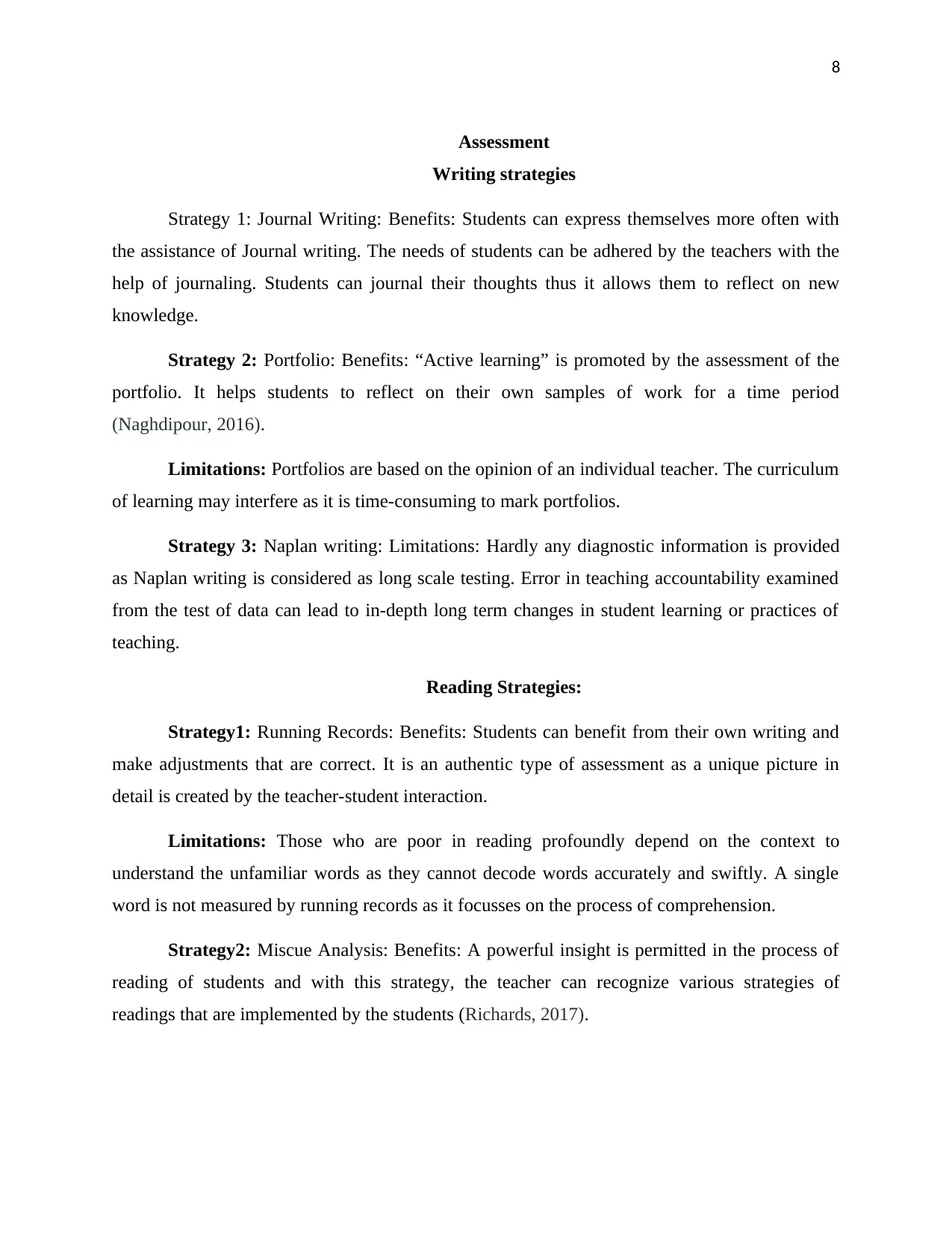
8
Assessment
Writing strategies
Strategy 1: Journal Writing: Benefits: Students can express themselves more often with
the assistance of Journal writing. The needs of students can be adhered by the teachers with the
help of journaling. Students can journal their thoughts thus it allows them to reflect on new
knowledge.
Strategy 2: Portfolio: Benefits: “Active learning” is promoted by the assessment of the
portfolio. It helps students to reflect on their own samples of work for a time period
(Naghdipour, 2016).
Limitations: Portfolios are based on the opinion of an individual teacher. The curriculum
of learning may interfere as it is time-consuming to mark portfolios.
Strategy 3: Naplan writing: Limitations: Hardly any diagnostic information is provided
as Naplan writing is considered as long scale testing. Error in teaching accountability examined
from the test of data can lead to in-depth long term changes in student learning or practices of
teaching.
Reading Strategies:
Strategy1: Running Records: Benefits: Students can benefit from their own writing and
make adjustments that are correct. It is an authentic type of assessment as a unique picture in
detail is created by the teacher-student interaction.
Limitations: Those who are poor in reading profoundly depend on the context to
understand the unfamiliar words as they cannot decode words accurately and swiftly. A single
word is not measured by running records as it focusses on the process of comprehension.
Strategy2: Miscue Analysis: Benefits: A powerful insight is permitted in the process of
reading of students and with this strategy, the teacher can recognize various strategies of
readings that are implemented by the students (Richards, 2017).
Assessment
Writing strategies
Strategy 1: Journal Writing: Benefits: Students can express themselves more often with
the assistance of Journal writing. The needs of students can be adhered by the teachers with the
help of journaling. Students can journal their thoughts thus it allows them to reflect on new
knowledge.
Strategy 2: Portfolio: Benefits: “Active learning” is promoted by the assessment of the
portfolio. It helps students to reflect on their own samples of work for a time period
(Naghdipour, 2016).
Limitations: Portfolios are based on the opinion of an individual teacher. The curriculum
of learning may interfere as it is time-consuming to mark portfolios.
Strategy 3: Naplan writing: Limitations: Hardly any diagnostic information is provided
as Naplan writing is considered as long scale testing. Error in teaching accountability examined
from the test of data can lead to in-depth long term changes in student learning or practices of
teaching.
Reading Strategies:
Strategy1: Running Records: Benefits: Students can benefit from their own writing and
make adjustments that are correct. It is an authentic type of assessment as a unique picture in
detail is created by the teacher-student interaction.
Limitations: Those who are poor in reading profoundly depend on the context to
understand the unfamiliar words as they cannot decode words accurately and swiftly. A single
word is not measured by running records as it focusses on the process of comprehension.
Strategy2: Miscue Analysis: Benefits: A powerful insight is permitted in the process of
reading of students and with this strategy, the teacher can recognize various strategies of
readings that are implemented by the students (Richards, 2017).
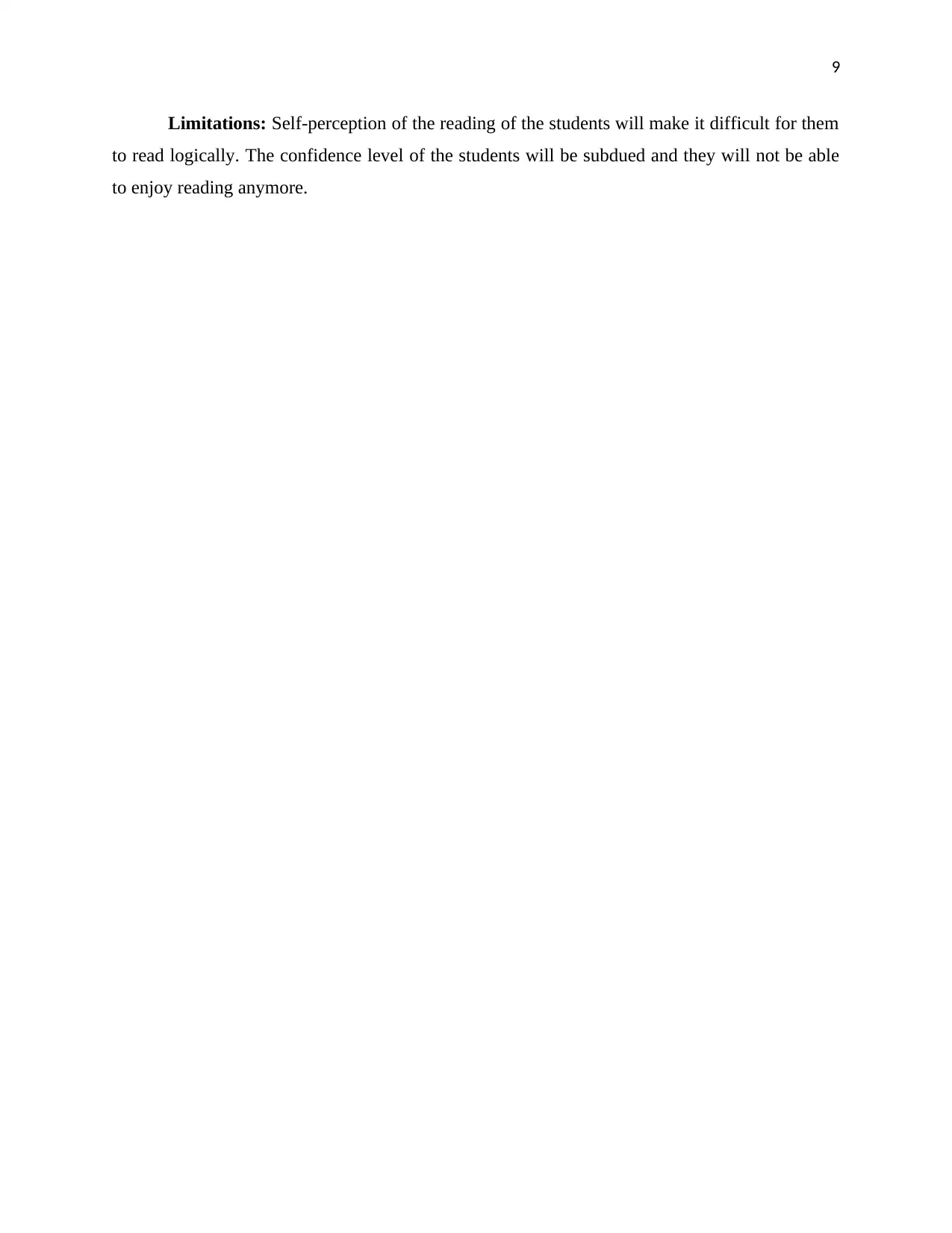
9
Limitations: Self-perception of the reading of the students will make it difficult for them
to read logically. The confidence level of the students will be subdued and they will not be able
to enjoy reading anymore.
Limitations: Self-perception of the reading of the students will make it difficult for them
to read logically. The confidence level of the students will be subdued and they will not be able
to enjoy reading anymore.
Secure Best Marks with AI Grader
Need help grading? Try our AI Grader for instant feedback on your assignments.
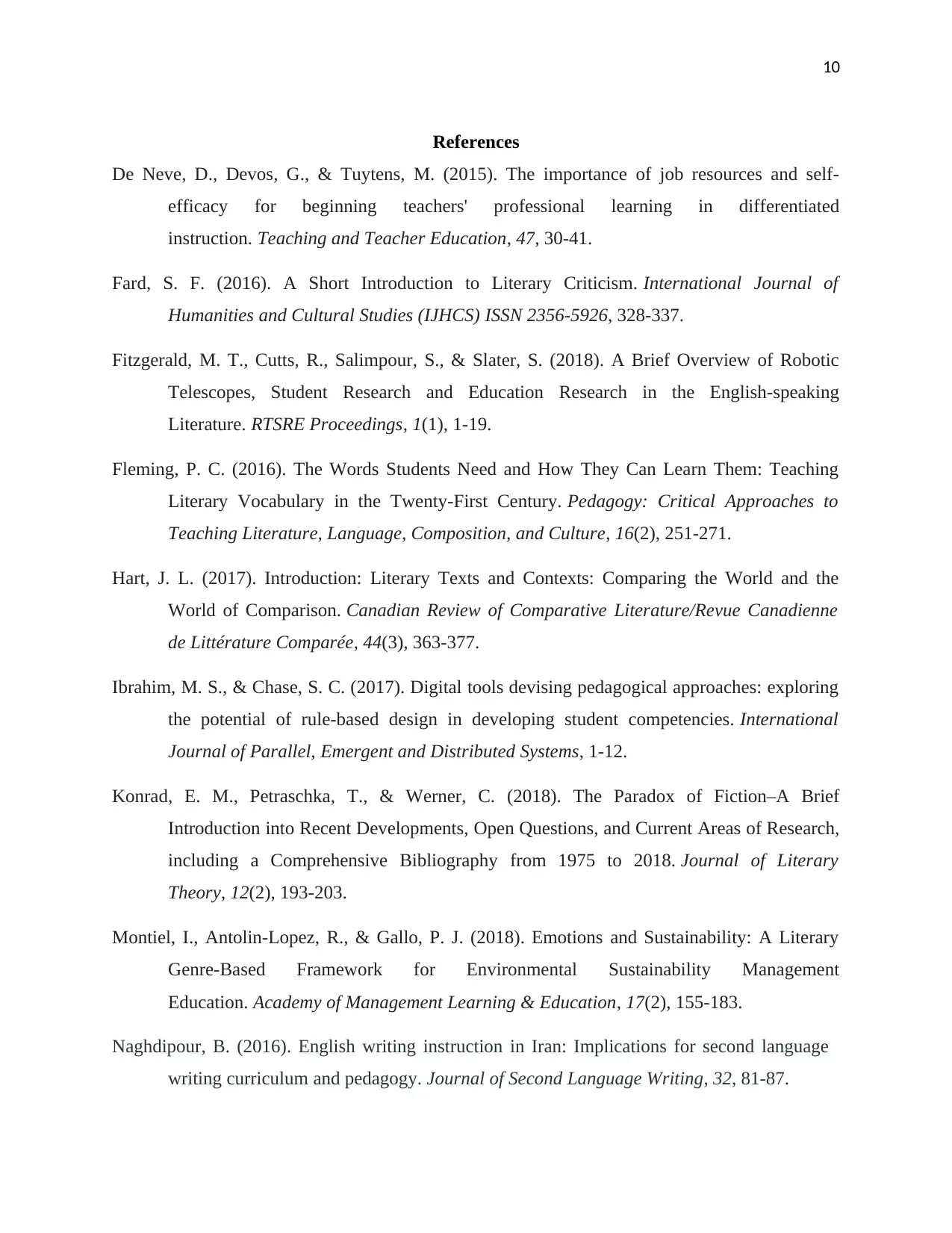
10
References
De Neve, D., Devos, G., & Tuytens, M. (2015). The importance of job resources and self-
efficacy for beginning teachers' professional learning in differentiated
instruction. Teaching and Teacher Education, 47, 30-41.
Fard, S. F. (2016). A Short Introduction to Literary Criticism. International Journal of
Humanities and Cultural Studies (IJHCS) ISSN 2356-5926, 328-337.
Fitzgerald, M. T., Cutts, R., Salimpour, S., & Slater, S. (2018). A Brief Overview of Robotic
Telescopes, Student Research and Education Research in the English-speaking
Literature. RTSRE Proceedings, 1(1), 1-19.
Fleming, P. C. (2016). The Words Students Need and How They Can Learn Them: Teaching
Literary Vocabulary in the Twenty-First Century. Pedagogy: Critical Approaches to
Teaching Literature, Language, Composition, and Culture, 16(2), 251-271.
Hart, J. L. (2017). Introduction: Literary Texts and Contexts: Comparing the World and the
World of Comparison. Canadian Review of Comparative Literature/Revue Canadienne
de Littérature Comparée, 44(3), 363-377.
Ibrahim, M. S., & Chase, S. C. (2017). Digital tools devising pedagogical approaches: exploring
the potential of rule-based design in developing student competencies. International
Journal of Parallel, Emergent and Distributed Systems, 1-12.
Konrad, E. M., Petraschka, T., & Werner, C. (2018). The Paradox of Fiction–A Brief
Introduction into Recent Developments, Open Questions, and Current Areas of Research,
including a Comprehensive Bibliography from 1975 to 2018. Journal of Literary
Theory, 12(2), 193-203.
Montiel, I., Antolin-Lopez, R., & Gallo, P. J. (2018). Emotions and Sustainability: A Literary
Genre-Based Framework for Environmental Sustainability Management
Education. Academy of Management Learning & Education, 17(2), 155-183.
Naghdipour, B. (2016). English writing instruction in Iran: Implications for second language
writing curriculum and pedagogy. Journal of Second Language Writing, 32, 81-87.
References
De Neve, D., Devos, G., & Tuytens, M. (2015). The importance of job resources and self-
efficacy for beginning teachers' professional learning in differentiated
instruction. Teaching and Teacher Education, 47, 30-41.
Fard, S. F. (2016). A Short Introduction to Literary Criticism. International Journal of
Humanities and Cultural Studies (IJHCS) ISSN 2356-5926, 328-337.
Fitzgerald, M. T., Cutts, R., Salimpour, S., & Slater, S. (2018). A Brief Overview of Robotic
Telescopes, Student Research and Education Research in the English-speaking
Literature. RTSRE Proceedings, 1(1), 1-19.
Fleming, P. C. (2016). The Words Students Need and How They Can Learn Them: Teaching
Literary Vocabulary in the Twenty-First Century. Pedagogy: Critical Approaches to
Teaching Literature, Language, Composition, and Culture, 16(2), 251-271.
Hart, J. L. (2017). Introduction: Literary Texts and Contexts: Comparing the World and the
World of Comparison. Canadian Review of Comparative Literature/Revue Canadienne
de Littérature Comparée, 44(3), 363-377.
Ibrahim, M. S., & Chase, S. C. (2017). Digital tools devising pedagogical approaches: exploring
the potential of rule-based design in developing student competencies. International
Journal of Parallel, Emergent and Distributed Systems, 1-12.
Konrad, E. M., Petraschka, T., & Werner, C. (2018). The Paradox of Fiction–A Brief
Introduction into Recent Developments, Open Questions, and Current Areas of Research,
including a Comprehensive Bibliography from 1975 to 2018. Journal of Literary
Theory, 12(2), 193-203.
Montiel, I., Antolin-Lopez, R., & Gallo, P. J. (2018). Emotions and Sustainability: A Literary
Genre-Based Framework for Environmental Sustainability Management
Education. Academy of Management Learning & Education, 17(2), 155-183.
Naghdipour, B. (2016). English writing instruction in Iran: Implications for second language
writing curriculum and pedagogy. Journal of Second Language Writing, 32, 81-87.
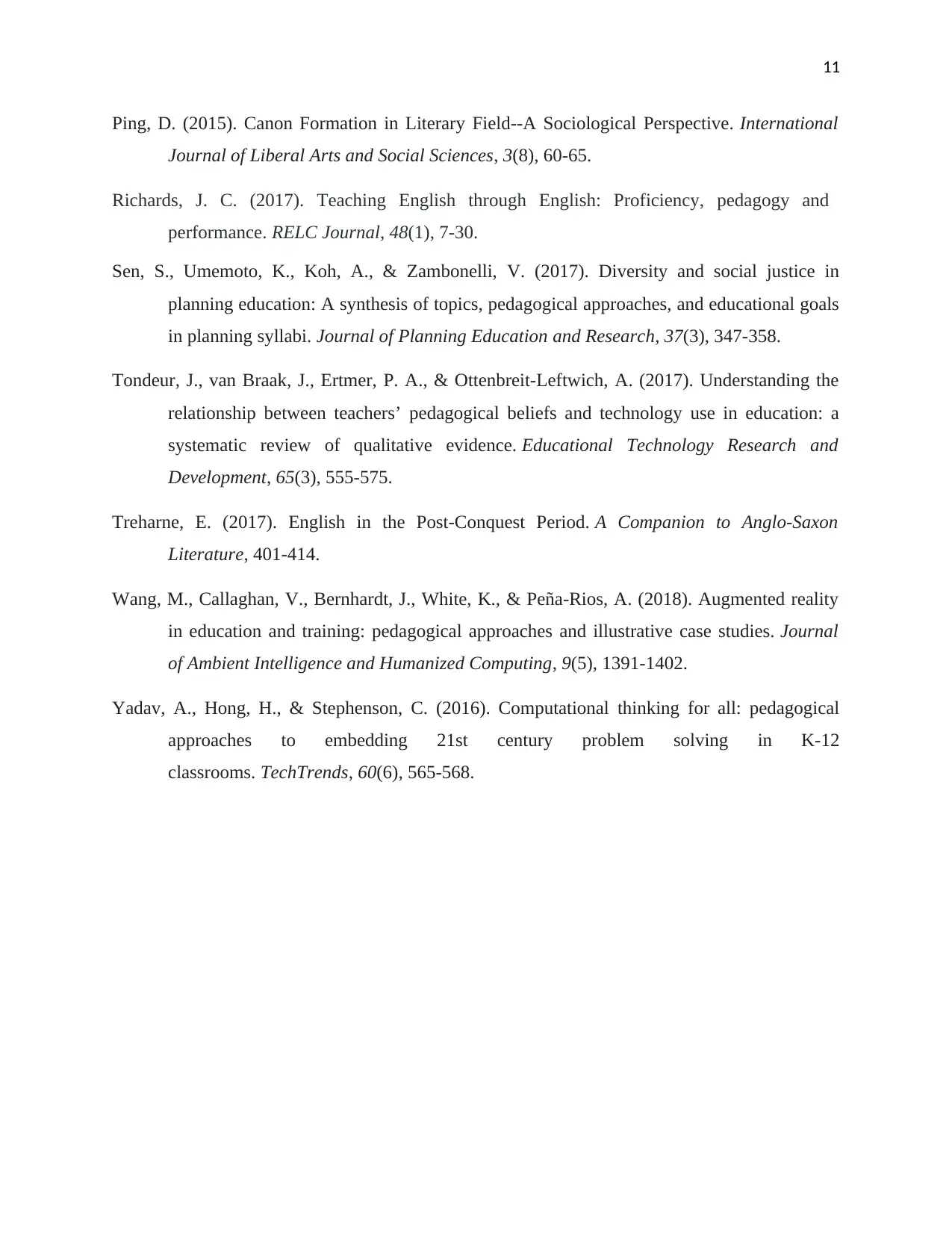
11
Ping, D. (2015). Canon Formation in Literary Field--A Sociological Perspective. International
Journal of Liberal Arts and Social Sciences, 3(8), 60-65.
Richards, J. C. (2017). Teaching English through English: Proficiency, pedagogy and
performance. RELC Journal, 48(1), 7-30.
Sen, S., Umemoto, K., Koh, A., & Zambonelli, V. (2017). Diversity and social justice in
planning education: A synthesis of topics, pedagogical approaches, and educational goals
in planning syllabi. Journal of Planning Education and Research, 37(3), 347-358.
Tondeur, J., van Braak, J., Ertmer, P. A., & Ottenbreit-Leftwich, A. (2017). Understanding the
relationship between teachers’ pedagogical beliefs and technology use in education: a
systematic review of qualitative evidence. Educational Technology Research and
Development, 65(3), 555-575.
Treharne, E. (2017). English in the Post‐Conquest Period. A Companion to Anglo‐Saxon
Literature, 401-414.
Wang, M., Callaghan, V., Bernhardt, J., White, K., & Peña-Rios, A. (2018). Augmented reality
in education and training: pedagogical approaches and illustrative case studies. Journal
of Ambient Intelligence and Humanized Computing, 9(5), 1391-1402.
Yadav, A., Hong, H., & Stephenson, C. (2016). Computational thinking for all: pedagogical
approaches to embedding 21st century problem solving in K-12
classrooms. TechTrends, 60(6), 565-568.
Ping, D. (2015). Canon Formation in Literary Field--A Sociological Perspective. International
Journal of Liberal Arts and Social Sciences, 3(8), 60-65.
Richards, J. C. (2017). Teaching English through English: Proficiency, pedagogy and
performance. RELC Journal, 48(1), 7-30.
Sen, S., Umemoto, K., Koh, A., & Zambonelli, V. (2017). Diversity and social justice in
planning education: A synthesis of topics, pedagogical approaches, and educational goals
in planning syllabi. Journal of Planning Education and Research, 37(3), 347-358.
Tondeur, J., van Braak, J., Ertmer, P. A., & Ottenbreit-Leftwich, A. (2017). Understanding the
relationship between teachers’ pedagogical beliefs and technology use in education: a
systematic review of qualitative evidence. Educational Technology Research and
Development, 65(3), 555-575.
Treharne, E. (2017). English in the Post‐Conquest Period. A Companion to Anglo‐Saxon
Literature, 401-414.
Wang, M., Callaghan, V., Bernhardt, J., White, K., & Peña-Rios, A. (2018). Augmented reality
in education and training: pedagogical approaches and illustrative case studies. Journal
of Ambient Intelligence and Humanized Computing, 9(5), 1391-1402.
Yadav, A., Hong, H., & Stephenson, C. (2016). Computational thinking for all: pedagogical
approaches to embedding 21st century problem solving in K-12
classrooms. TechTrends, 60(6), 565-568.
1 out of 12
Related Documents
Your All-in-One AI-Powered Toolkit for Academic Success.
+13062052269
info@desklib.com
Available 24*7 on WhatsApp / Email
![[object Object]](/_next/static/media/star-bottom.7253800d.svg)
Unlock your academic potential
© 2024 | Zucol Services PVT LTD | All rights reserved.





